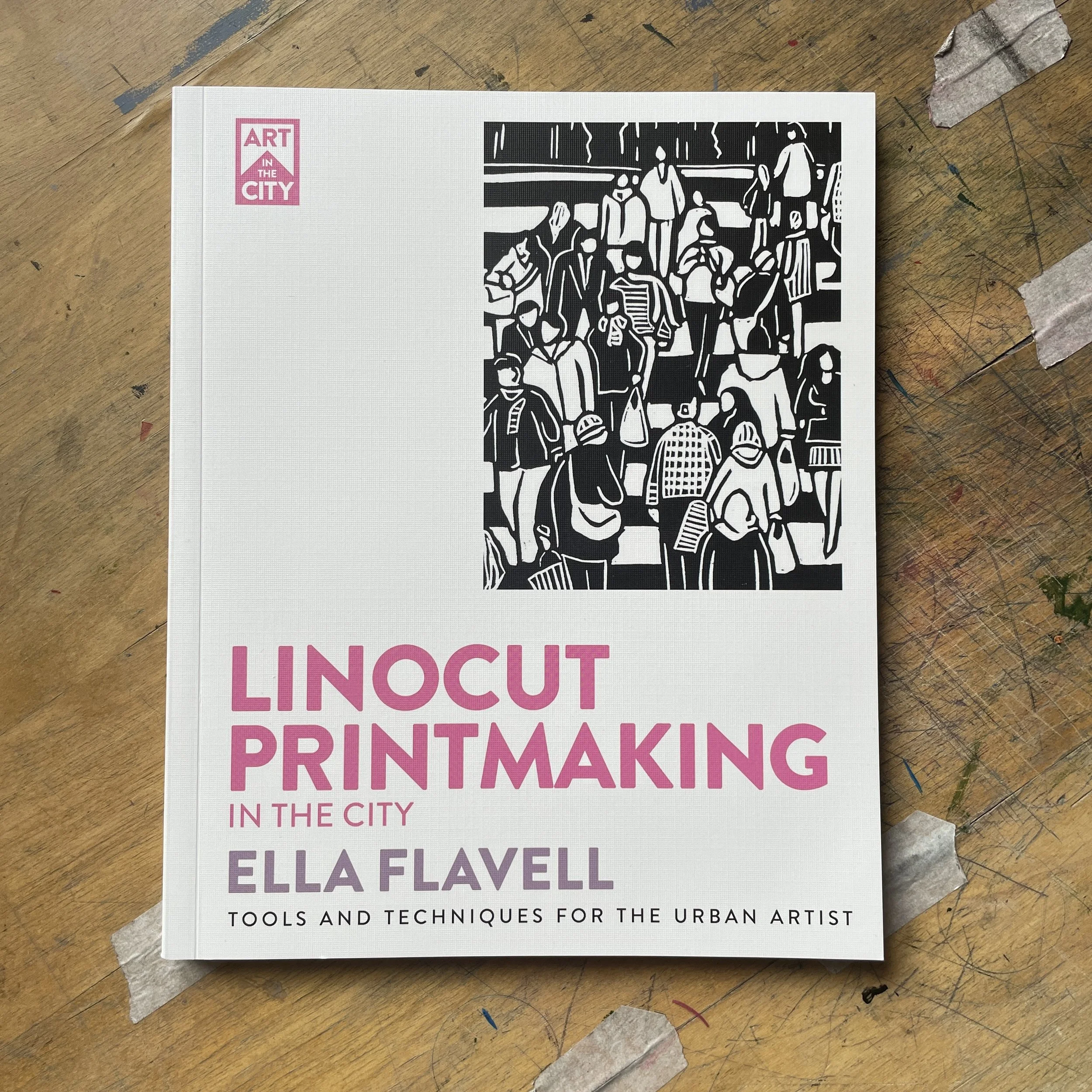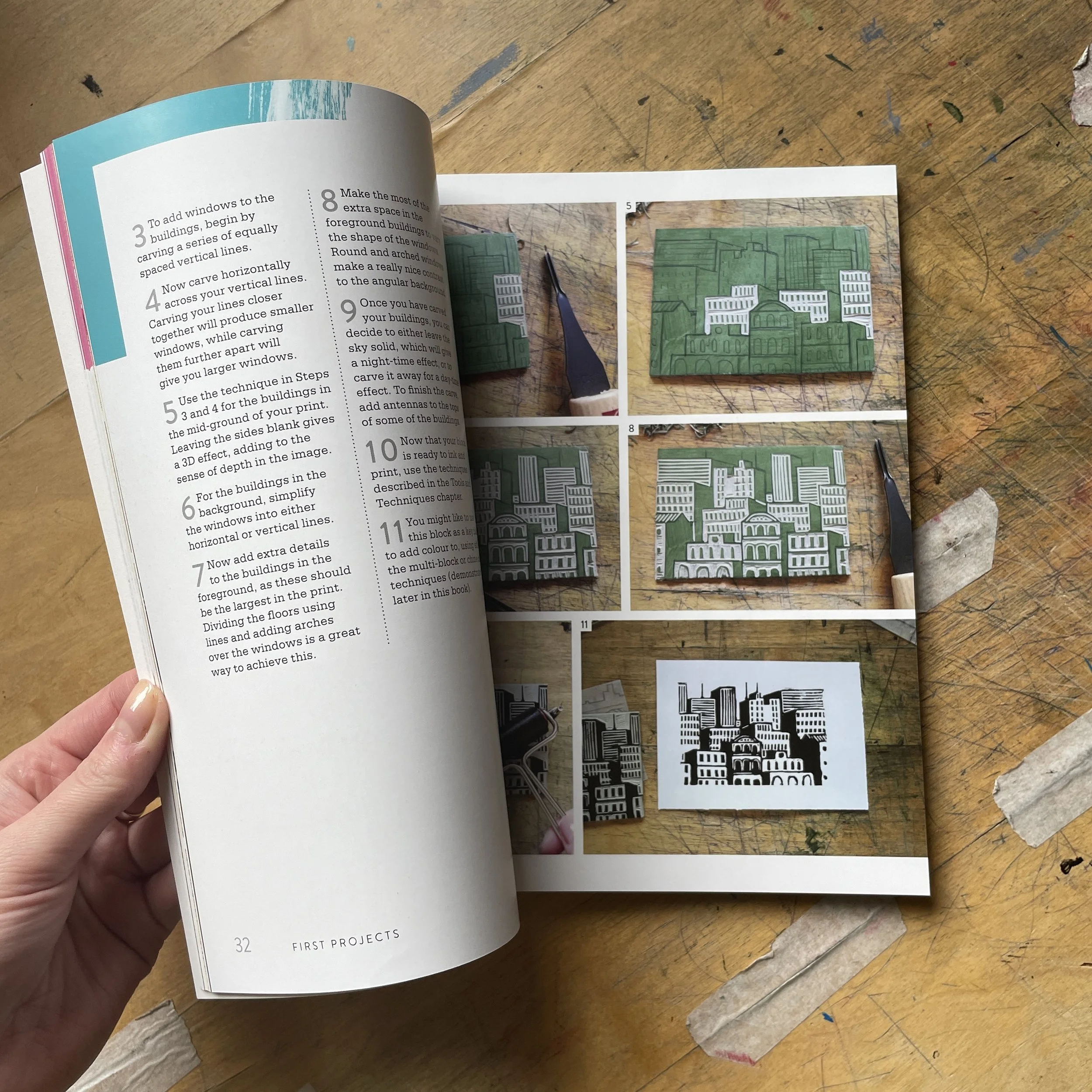Behind the Scenes of Linocut Printmaking in the City
To celebrate the publication of my first book, Linocut Printmaking in the City (published by David & Charles), here’s a little behind the scenes look into the making of the book, from planning seventeen new print projects to losing over two hundred photos due to a memory card failure …
The Book
I was approached by David & Charles publishing in Spring 2024. They had seen my work on Instagram and asked if I would be interested in writing a book about printmaking, specifically making prints with the urban environment as their subject. I’ve been dreaming about writing a book since I was a kid, so of course I jumped at the chance! Within a few months we had the basic outline of the book, and now my task was to get to writing, printing, and photographing all the new projects to fill the book. We decided on five main sections: Tools and Techniques; First Projects; Inspiration Finder; Mixing Media; and Further Studies. By December 2024 the first full draft of the book was complete: 17 new projects, lots of writing, and 1000s of photos!
Tools and Techniques
The first section of the book explores the tools and techniques needed to start linocutting, from how to set up your printmaking space to tips and tricks for inking and printing. As well as being the first section in the book chronologically, it was also the first section I wrote - I remember making some notes for this section while at a maker’s market at the Custard Factory in Dibgeth, Birmingham, because the room was freezing cold and I was shivering, leading to some almost indecipherable notes! I also used this section to develop the tone and voice for the book. I wanted it to be friendly and almost conversational, while also clear and informative. My background (and current job) is as a PhD researcher, which requires a very different writing style and tone, so it took a lot of drafts before I was happy.
First Projects
The First Projects section includes seven different printmaking projects, aimed at beginner printmakers or experienced printmakers looking to try new subjects - and a lot of these were new subjects for me, too! The step-by-step style of writing was also a new format for me, and it became an interesting way to examine my own practice: what do I do automatically that I need to make a note of here? What should be included and what should be left out? Another key aspect that came up in the step-by-step process was making sure I took photos of every stage to accompany the text. The images needed to be clear, so I used the “fancy camera” that we’ve had for over ten years which worked perfectly … until it didn’t.
Inspiration Finder
The issue with the camera didn’t manifest itself until I was photographing images for the Inspiration Finder section. In this section I combined photographs of my own prints that related to a specific theme (such as night-time, engineering, and personal stories) with some text discussing these sources of inspiration and how I use them in printmaking. I was in the habit of uploading all the photos I had taken at the end of every day to my laptop, just in case (which, in hindsight, was the best idea I had). At the end of a particularly long day of photographing, taking multiple photos of different flat lays, tools, and some project steps, I went to upload the photos and … they weren’t there. The memory card was empty. I couldn’t even blame the ten year old camera as it was 100% user error: in my eagerness to start photographing I’d just inserted the memory card without formatting it (still not completely sure what that means) and had started snapping away. My luck had (somehow) held out for so long, but eventually the camera had enough and wiped the memory card. Over 200 photos had vanished. After a little bit of a cry (justifiable in the circumstances!) I started the long task of re-creating the photos (including re-doing a whole project for the First Projects section, which included re-carving and printing the block from scratch) - making sure that I had formatted everything correctly this time. Whoops.
Mixing Media
After the debacle with the camera I was taking no chances with these final two sections, which included some of the more complicated prints and projects, and took backup photos on my phone - doubling the time everything took but it was way better than the alternative! This section was a lot of fun to plan and work on, and I got to re-learn some printmaking techniques I’d not tried in years, including a form of collagraph printing that I’m keen to try more of in my own practice.
Further Studies
The final section included some more complex prints, and ideas for future projects for new printmakers who had followed along with the book. This section includes two of my favourite projects in the whole book, the multiblock print and the continuous landscape printing project. By now I was in the groove of writing and printing, and it was exciting (and daunting!) to come to the end of the first draft, and start the process of editing.
Publication!
The first few months of 2025 were spent editing the text, working with the publishers on the arrangement and design, and sending off all the final prints to be professionally photographed (these photos are one of my favourite aspects of the book!). Seeing the first PDF of the finished book was an incredibly exciting moment, topped only by holding the first physical copy a few months later. Once the book was finalised, all that was left was to wait for publication day, on October 21st 2025. Despite some stresses (losing the photos and juggling writing alongside being a full-time student and managing my own printmaking) writing Linocut Printmaking in the City was a wonderful experience, and I am so grateful that I got the opportunity to live out a childhood (and adulthood) dream. I’m so excited that it’s now out in the world and available in so many bookshops and websites worldwide, and I hope it encourages lots of new printmaking adventures.



